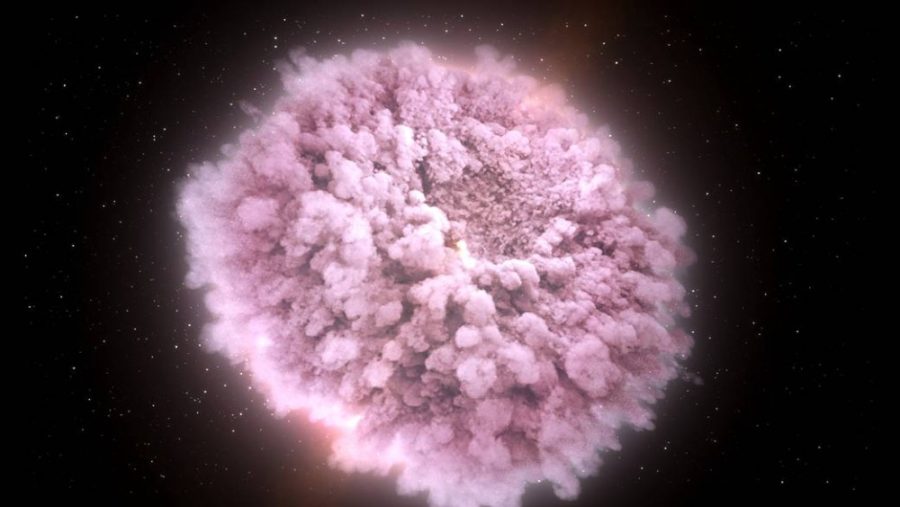On Aug. 17, the Laser Interferometer Gravitational Wave Observatory (LIGO) detected gravitational waves from the depths of space, swiftly followed by a gamma ray burst detection from NASA’s Fermi space telescope.
University of Arizona astronomer and supernovae investigator David Sand was one of the scientists who quickly began analyzing the event.
Sand said he rents a small, 16-inch telescope in Chile, used primarily for finding supernova in nearby galaxies. He and several other astronomers signed an agreement with LIGO to gain access to detections when they happen, so they could begin research immediately.
“We didn’t think anything would come of it, but we wrote the software so we can respond to these things,” Sand said. “We implemented the program we had in place for black hole mergers; all I had to do was make a few tweaks.”
Gravitational waves are disruptions in the very fabric of space-time, bending and squishing things on a scale even smaller than protons. LIGO works by detecting these subatomic contractions with two elongated arms and lasers shot from each arm. To ensure a detection isn’t merely a fluke, two LIGO detectors exist to check each other.
RELATED: One year after launch, OSIRIS-REx flies by Earth
This is the first time gravitational waves and a Gamma Ray Burst (GRB) have been detected in tandem, making this an exceptional discovery for the field of astronomy, according to Sand. The origin of these detections come from the collision of two neutron stars, hyper-dense stars only a few kilometers wide and 1.1 to 1.6 times more massive than the sun.
Last year, LIGO detected gravitational waves from the collision of two black holes, Sand said, so while this may not be the first gravitational wave detection, it’s the first from the collision of two neutron stars.
“This alone was very exciting, these black hole mergers, but people did not expect to see neutron star mergers for another few years,” Sand said. “It wasn’t clear if LIGO had the sensitivity yet or how often these events happen.”
The event took place only 130 million light years away, very close from an astronomical perspective, Sand said. Light waves were also emitted from this collision, allowing for telescopic observations to be made.
“We didn’t know for sure we’d see light, and that’s why astronomers have been clamoring to study this event,” Sand said. “As the years go on, this still may be one of the best-studied events because of how close it is. We can’t expect anything closer to happen any time soon.”
The observed collision only lasted a few days and was not as strong as nor did it look like a supernova, and has such been dubbed as a kilonova, according to Sand. Models and predictions have been made for kilonova.
“One of the surprises was that the models matched the observations, though there’s a bunch of little details that we’re trying to figure out,” Sand said.
RELATED: Cassini spacecraft ending 20-year mission by crashing into Saturn
This discovery gives further proof to Einstein’s theory of relativity, according to Sand, which current observations have shown no great deviations from. The first detection of light came within two seconds of the gravitational waves, confirming gravitational waves move at about the same speed as light.
“The real world is messier than equations. You have to model these things with computers, so in a lot of ways we’re learning new computational techniques,” Sand said.
While the Fermi telescope constantly searches for gamma rays, this is the first time gamma rays have been associated with a neutron star collision. Astronomers have expected GRBs and gravitational waves to be linked, but this GRB detection was weaker than expected.
“It’s an oddity in that we’re just barely able to detect these,” Sand said. “We think it’s weaker because the bursts are pointed in two directions like a beam and we were off axis.”
In other words, Sand said, we only barely caught the burst.
Sand also sees this as a perfect beginning for multi-messenger astronomy, a method of research using multiple different sources. He said in this method, you have light as a messenger, but another messenger might be gravitational waves. The messenger could be anything that can be detected and analyzed.
“When you combine these, you learn more than you would with just one,” Sand said.
Last year’s LIGO detection only found gravitational waves, according to Sand, and this year the waves were accompanied by light and a GRB.
RELATED: Gravity field mapping can give an insider’s view of the moon
Another important aspect of this observation is the Hubble constant, or the rate of expansion of the universe. To find this, Sand said, one needs the distance and the velocity.
The issue with this is that, due to the sheer mind-bending scope of the universe, distances are hard to gauge, but the gravitational waves help solve that problem.
“The signature of the gravitational waves themselves and the amplitude gives you a distance, and with the expansion velocity, this tells you the Hubble constant,” Sand said.
This is, however, the first time scientists made such a measurement, Sand said, as without an optical signature, previous black hole mergers could not give an expansion rate.
“You need to see it in light so you can see its host galaxy and measure the expansion and how fast that galaxy is moving away from us,” Sand said.
With LIGO constantly upgrading its technology, Sand said he hopes he’ll be able to detect events like these once every month soon enough.
Follow William Rockwell on Twitter









